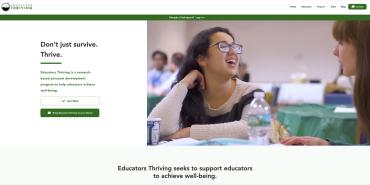Two months into his teaching career, Tyler Hester’s mother took him to breakfast—because that was the only time he could squeeze in a visit—and he was so overwhelmed with his new job, he cried into his pancakes. Dozens of AFT members at Hester’s workshop could relate; they shared similar experiences in the chat box during his virtual AFT TEACH conference workshop, “We Must and Can Do Better: Five Pitfalls to Avoid to Help Educators Thrive,” on July 9.
To say there is a need to address stress among educators would be an understatement. The learning curve for new teachers is notorious, but even veterans have struggled over the past year and a half, said Paul Tritter, director of professional learning for the Boston Teachers Union. COVID-19 “made so many of us feel like first-year teachers again.”
That’s why the BTU applied for and received an AFT Innovation Fund COVID-19 response grant to expand its partnership with Educators Thriving, the organization Hester founded to offer tools and insights to cultivate well-being among educators. The program—and the grant that funded it—“made a really big difference in our ability to support members this year,” said Tritter. The union is about more than the “bread and butter … of contract negotiations and representation in the workplace. It’s also about professional growth. … It’s about equity and social justice … [and how] we support our members’ well-being.”
Rejuvenation and reflection to the rescue
Hester, who is a high school teacher in Stockton, Calif., led participants through the familiar emotional journey of an educator, one that occurs not just at the beginning of a career but at the start of the school year as well. First there is eager anticipation, often followed by survival mode, when demands feel overwhelming; next is disillusionment and, for too many educators, the exit door, when teachers leave the profession.
“One of the core ideas behind Educators Thriving is … that it doesn’t have to be this bad,” said Hester. He applies science-based knowledge about well-being, providing an alternative path of rejuvenation and reflection that leads back to that eager anticipation of a new school year.
Twenty years ago, social and emotional learning (SEL) for students was not widely understood, said Hester; now it is a core tenet of teaching. Why not SEL for adults?
Educators Thriving outlines five common pitfalls for educators and presents a program of personal development for avoiding them. The pitfalls are:
- Feeling overwhelmed, when, as Hester described it, “there’s more to do than we can possibly do.”
- Personal neglect, when basic needs like sleep and healthy eating fall away.
- Fixed mindsets, such as the notion that we are not able to become the educators we want to be.
- Unexpected challenges, which were countless during the pandemic.
- A sense of isolation, when that classroom door closes and you are on your own with your students, too often with no support.
Participants shared examples of these pitfalls in their own lives. For example, there were students who never showed up during remote learning, standardized tests for students whose academic learning was stalled during the pandemic, fears over unvaccinated students returning to school buildings and a lack of information from school districts about plans for a return to in-person learning.
“It was great to be hearing somebody else’s point of despair as well as triumph, … and what we did to overcome,” said one participant.
Getting to better
On a more personal level, workshop participants reflected on how to prioritize overwhelming demands, paring away less important but time-consuming items to focus on more rewarding ones. Using a chart that categorized activities from most worthy of attention to least, Hester stacked priorities with relatable examples of tasks that are
- important but not urgent (like longer-term planning and building relationships);
- important and urgent (like crises and deadline-driven projects),
- not important but urgent (like taking advantage of the department store sale before it’s over); and
- not important or urgent (like mindless TV and excessive scrolling through social media).
Participants had time to insert personal examples in each category, suggesting changes they could make in their own lives to accomplish what is most important to them. They also named specific intentions for themselves, by answering the question, “What’s one thing you could be doing … that would make a really positive difference in your life, if you did it on a regular basis?” Aspirations included daily walks, learning a new language, exercising and sleep.
Research shows that committing to intentions in a specific way is far more likely to result in accomplishing the goal, said Hester. For example, writing that you will exercise for 20 minutes on a specific day at a specific time and place is more likely to produce results than a vague commitment to exercise more.
The chat box lit up again toward the end of the session with gratitude for the hands-on exercises and tools participants could take home to ease the stress of an unprecedented year. Members were also able to tap a deep reservoir of resources, including videos and exercises on well-being that will strengthen them throughout the school year and allow them—and their students—to thrive.
[Virginia Myers]

